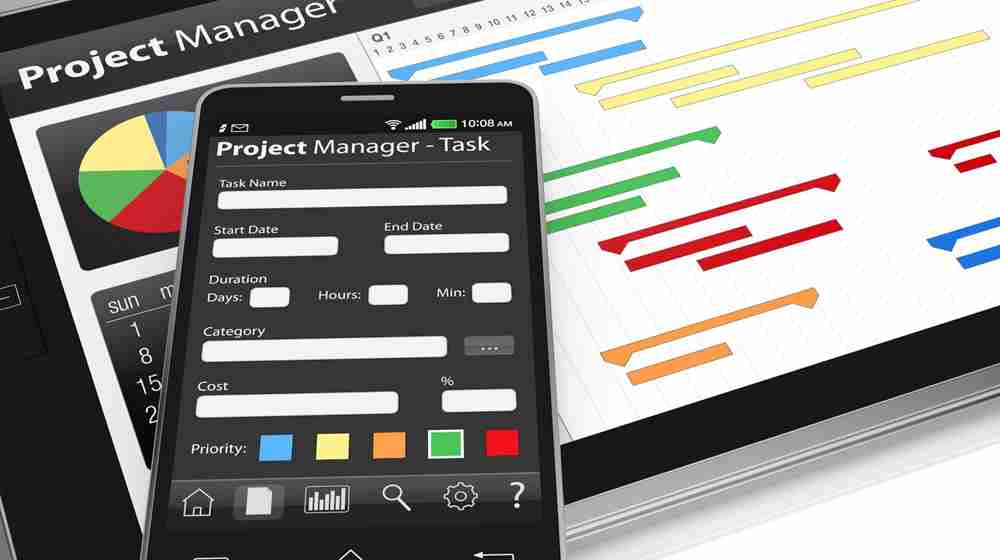Buying Project Management Software
12 June 2022

Our review of the top 19 Project Management packages
With the rapid acceleration of remote and hybrid working brought about by the COVID-19 pandemic, the use of project and task management software has taken on an even greater importance. While not so long ago a printed plan produced by a project manager and handed around the office was sufficient, in today’s world of distributed teams it’s just about impossible to manage a project without using one of these tools.
Loss of control is one of the major anxieties stated by senior management regarding hybrid and remote work. Project and task management software helps resolve this. Most tools allow you to manage individual projects as well as a portfolio of projects and attach costs, resources and timescales to each. Crucially, they allow senior management to be able to instantly call up management information containing performance data across the entire project portfolio.
A crowded, complex marketplace
There are huge numbers of project and task management packages out there – at the last count well in excess of 200, resulting in a complex, crowded marketplace. Leading research organisation MarketandMarkets have estimated the market for project management tools to be worth around $2 Billion in 2017, growing to $4.3 Billion by 2023 with an annual growth rate of over 13%. With this level of growth new tools keep appearing all of the time, but having carried out a similar survey 5 years ago, while every vendor we looked at then is still around, many have been absorbed by bigger companies, wanting to combine a project planner into their portfolio.
This guide aims to help you through the difficult task of buying project management software.
No longer the preserve of big companies
Project management tools used to be the preserve of big companies who have utilised them for decades. However, with software now available via the cloud on a subscription model based primarily on use, their adoption by all sizes of businesses in recent years has increased very rapidly.
Cloud and collaboration
All of these applications are available as a service via the cloud, so you don’t need to buy any special infrastructure, just pay your subscription, point your browser to the right place and go.
Most vendors also offer collaboration space in the cloud, where plans and documents can be shared and reviewed and project team members can communicate via messaging. Often a client portal is available so you can share usually a more limited view of the project information with a partner or client.
Any device anywhere
Increasingly, project teams are located in disparate locations and it’s not unusual for teams to consist of staff based in an office, at home and a variety of other locations, sometimes not even on the same continent.
All of the packages will give you access through a browser and most through a mobile app, allowing you to read and update project data through pretty much any device and at just about any location as long as it has access to the internet.
Subscription based
Another common theme is that like most cloud-based software, these tools are subscription based. This is usually by a monthly charge although most vendors want you to sign up to an annual contract or at least encourage this by offering substantial discounts to customers who sign up for one or two years. Nearly all vendors offer a free 14 or 30 day trial and some a limited functionality configuration of package free for life as a taster to tempt you into their paying versions. Some vendors will sell and support versions that can run on your own IT infrastructure but most aren’t open to this.
Not a commodity market
If you thought all of these packages were basically the same, you’d be very wrong. Packages offer differing functionality and varied pricing and it’s important to fully understand both what is on offer and what you want before buying. Buying project management software in this crowded and varied market is more about value – price alone isn’t always a reliable guide to how good or functionally rich these tools are.
As for buying anything, if you don’t know what you want then you’ll almost certainly get your fingers burned. We strongly recommend you read our blog post on what features to look for in a project management package before even thinking about making a decision on one of these tools.
Not a single market
We’ve looked at the leading tools in the market and while much of the online review material gives the impression that these tools are basically all very similar, this is most definitely not the case. We see five categories of tools in this market
- Agile Project Management Tools
- Task Management Tools
- Classic Project Management Tools
- High End Project Management Tools
- Large Enterprise level tools.
Product Reviews
We’re in the process of reviewing around 20 tools – these reviews will be published as we complete them. Click on the links below.
Pricing should reflect functionality, so please bear these categories in mind when buying project management software to make sure you don’t end up paying High End Project Management prices for Task Management Tools.
Agile Project Management Tools
So, the Agile tools are tailored to that methodology and while it is possible to use Agile for any application, it is predominant used for IT projects. These tools are specialised for that market but vary from cheap tools that can maintain a backlog and support sprints and Kanban boards to comprehensive tools that support running a portfolio of Agile projects.
The Agile tools we’ve assessed are
Task Management Tools
Task Management Tools all allow task management but with less sophisticated scheduling, costing and reporting capabilities. Most offer some collaboration functionality and in fact many are more collaboration tools with a bit of task management than out-and-out task management tools.
The task management tools that we’ve assessed are
Classic Project Management Tools
Classic Project Management Tools support all of the functions you would expect to see in a project management package. They all have capable task management, support Gantt views, allow time recording and most will show actuals against estimated. They all have decent reporting and most fully support the costing of projects and tasks. Collaboration functionality is also common in these tools.
The classic project management tools we’ve assessed are
High End Project Management Tools
The high-end tools support everything you get in a classic project management tool but in a more comprehensive and usually very flexible way. They will often include the ability to build processes and to capture and manage Risks and Issues and track Change. These tools will support your business regardless of what size it grows to. They are just below the Enterprise level tools sold by the likes of Oracle and Hewlett Packard, but not by much. Pricing can vary dramatically.
The high-end tools we’ve assessed are:
Enterprise level tools
Enterprise level tools are costly and aimed at very large companies. These packages are more likely to run on a large company’s own IT infrastructure than in the cloud and are outside of our product reviews.
Training, Onboarding and User Guides
Training will be important and is usually an additional cost. I’d recommend you get your users trained by the supplier, so that people can ask questions. Usually this can be done remotely, rather than face-to-face, which keeps the costs down and clearly works better for remote workers.
Most vendors will combine an on-boarding and training package and you’ll have to pay a one-off charge for this. On-boarding isn’t necessarily simple. You might have data to transfer from the package you’re using now and most of these packages are highly configurable and they need to be set up appropriately for you. Also take a look at the user guides that come with the package. The best facilities tend to be searchable reference guides and short videos.
Changing your mind might be more difficult than you think
If you’re thinking because these tools are subscription based, that if the package doesn’t turn out to be right for you then you can easily move on….think again!
Having committed to a package, you’ll invest a huge amount of time into making it work for you. You’ll train staff, build standards, build plans and resource profiles into it and start filling it up with project documents, messaging threads and review comments. All of this is going to make it difficult and painful to change.
Vendors know this, which is why many offer subscription free starter packages.
We’ve worked with companies who have purchased what have turned out to be poor value tools, with significant deficiencies, but even so were unwilling to change because of the effort involved and that they were simply too busy. When buying project management software, it’s important to make the right choice first time.
Pricing
Well the good news is that pricing starts at zero, but before you get too excited, you should note that vendors aren’t charities. The strategy for many vendors is to start you off at low or no cost with a version of their software with limited functionality and then upsell when you inevitably start to find that you need to do more. As we said earlier, once you start using one of these tools in anger, it becomes hard to move away. Suppliers know this. Going for the cheapest package before looking closely what it delivers is highly likely to be a waste of time and money.
The free or trial versions give you the opportunity to evaluate one or a number of packages to determine which is the right one for you. In an evaluation it’s important you’re clear about what you want to get from a package and try to attach priorities to your requirements. Make sure you don’t try to evaluate too many packages, get down to a shortlist of three or four. Check out our post on what features to look for in a project management package to help you understand what functionality you might need. When you decide which one best meets your requirements, I’d strongly recommend you get a free trial and try to use it with some real work. The problem with free trials is that people use them to play about with a package, but rarely use them in anger. I’d strongly recommend using the trial to produce real plans for a project – it’s only then that you’ll start to identify any issues or omissions.
Pricing is often on a per-user basis, but sometimes charging is by active projects. You need to decide which model works for you. Be careful to ensure that any features that you’ve assumed are included for free really are included. It’s common to charge extra for a BI package and for integrations with other software. Storage may be limited too. This can all result in the costs increasing dramatically above your initial assumptions so check what you’re going to get for your money.
What can this guide do for you?
Hopefully it can help prevent you making an expensive mistake. Because everyone’s in a rush, without a lot of time to dedicate to looking at such a big market, it’s easy to get drawn in by the companies with the biggest advertising budgets. But this is a mistake, they’re often the poorest value tools. So take time to survey a wide number of tools before making your choice. Once you buy a package as we’ve already said, you’ll invest so much time in it, you won’t be volunteering to change in a hurry.
One of the companies that we’ve worked with bought a tool that didn’t include employee time tracking, so rather than change to a package that did, they found it less hassle to buy a separate time recording system and then try to link them together. Another struggled with the way the package scheduled activities and found that it didn’t support the notion of a fixed price project very well, which given they were an IT shop, wasn’t great. Again, they’ve worked around it, but could have saved themselves a lot of hassle if they’d known this when selecting a tool.
Both ran a free trial to evaluate the package before buying it, but as we mentioned earlier, free trials tend not to show up all of the limitations; it’s only when you start using the software in anger that the deficiencies start to be clear.
Some of the companies buying these packages have never used a project management tool before, so as often happens in that scenario, they end up having to learn from their mistakes. Knowing what you want is so important. We strongly recommend you read our blog post on the features you should look for in a project management package before taking to vendors or trialling packages.
Finally
We hope this guide helps. Please take a look at the individual package reviews and contact us if you need help with buying project management software. We can write requests for tender, run the procurement process, get a competitive price and reduce the risks in this process.
Liked our guide to buying Project Management software? Look at our other product reviews in our reviews section.
Articles and reviews on this site are written from an unbiased viewpoint. We only review products which are relevant to Remote Work or Project Management and ones we believe in. Once this guide to buying project management software was written we looked to see if some of the links could generate affiliate income. It won’t make us rich but it helps pay the rent!


